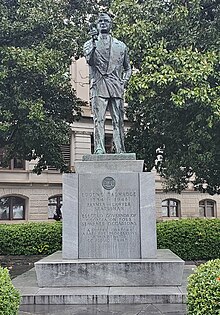
Thomas Edward Watson was an American Populist and white supremacist politician, attorney, newspaper editor, and writer from Georgia. In the 1890s Watson championed poor farmers as a leader of the Populist Party, articulating an agrarian political viewpoint while attacking business, bankers, railroads, Democratic President Grover Cleveland, and the Democratic Party. He was the nominee for vice president with Democrat William Jennings Bryan in 1896 on the Populist ticket.

Herman Eugene Talmadge was an American politician who served as governor of Georgia in 1947 and from 1948 to 1955 and as a U.S. senator from Georgia from 1957 to 1981. A Democrat, Talmadge served during a time of political transition, both in Georgia and nationally. He began his career as a staunch segregationist known for his opposition to civil rights, ordering schools to be closed rather than desegregated. But by the later stages of his career, following the enactment of the Voting Rights Act, which gave substance to the Fifteenth Amendment enacted nearly one hundred years before, Talmadge, like many other Southern politicians of that period, had modified his views. His life eventually encapsulated the emergence of his native Georgia from entrenched white supremacy into a political culture where white voters regularly elect black members of Congress.

Eugene Talmadge was an attorney and American politician who served three terms as the 67th governor of Georgia, from 1933 to 1937, and then again from 1941 to 1943. Elected to a fourth term in November 1946, he died before his inauguration, scheduled for January 1947. Only Talmadge and Joe Brown, in the mid-19th century, have been elected four times as governor of Georgia.
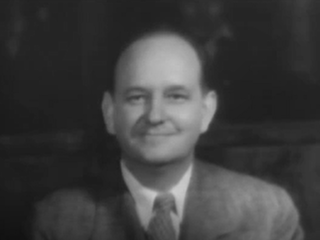
Ellis Gibbs Arnall was an American politician who served as the 69th Governor of Georgia from 1943 to 1947. A liberal Democrat, he helped lead efforts to abolish the poll tax and to reduce Georgia's voting age to 18. Following his departure from office, he became a highly successful attorney and businessman.
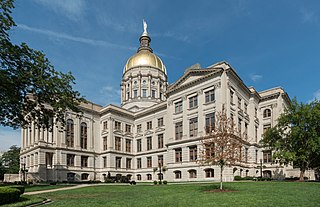
The Georgia State Capitol is an architecturally and historically significant building in Atlanta, Georgia, United States. The building has been named a National Historic Landmark which is listed on the National Register of Historic Places. As the primary office building of Georgia's government, the capitol houses the offices of the governor, lieutenant governor, and secretary of state on the second floor, chambers in which the General Assembly, consisting of the Georgia State Senate and Georgia House of Representatives, meets annually from January to April. The fourth floor houses visitors' galleries overlooking the legislative chambers and a museum located near the rotunda in which a statue of Miss Freedom caps the dome.

"Fiddlin'" John Carson was an American old-time fiddler and singer who recorded what is widely considered to be the first country music song featuring vocals and lyrics.

Benjamin Wynn Fortson Jr. was a Secretary of State of Georgia. After being selected by Ellis Arnall, the governor in 1946, Fortson kept his title as secretary until 1979, making him the longest-running secretary in Georgia history.

The three governors controversy was a political crisis in the U.S. state of Georgia from 1946 to 1947. On December 21, 1946, Eugene Talmadge, the governor-elect of Georgia, died before taking office. The state constitution did not specify who would assume the governorship in such a situation, so three men made claims to the governorship: Ellis Arnall, the outgoing governor; Melvin E. Thompson, the lieutenant governor-elect; and Herman Talmadge, Eugene Talmadge's son. Eventually a ruling by the Supreme Court of Georgia settled the matter in favor of Thompson. Georgia's Secretary of State Ben Fortson hid the state seal in his wheelchair so no official business could be conducted until the controversy was settled.

The 1948 Georgia gubernatorial special election took place on November 2, 1948, in order to elect the Governor of Georgia.

Jefferson Davis, created by Henry Augustus Lukeman, is a bronze sculpture of Jefferson Davis – a U.S. Senator, U.S. Secretary of War, plantation owner and the only President of the Confederate States of America – commissioned by the U.S. State of Mississippi for inclusion in National Statuary Hall Collection at the United States Capitol's National Statuary Hall, in Washington, D.C. The statue was controversial at the time of its unveiling and there have been multiple efforts to remove it from the Capitol since 2015.
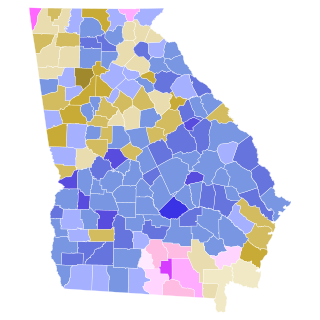
The 1946 Georgia gubernatorial election took place on November 5, 1946, in order to elect the Governor of Georgia.
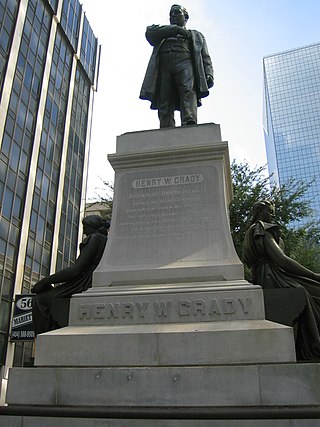
The Henry W. Grady statue is a monumental statue of Henry W. Grady in Atlanta, Georgia, United States. Built by Alexander Doyle in 1891, the statue lies at the intersection of Marietta Street and Forsyth Street in downtown Atlanta and was unveiled shortly after Grady's death in 1889. The statue has recently been the subject of controversy, as several groups have called for its removal due to Grady's support of white supremacy.
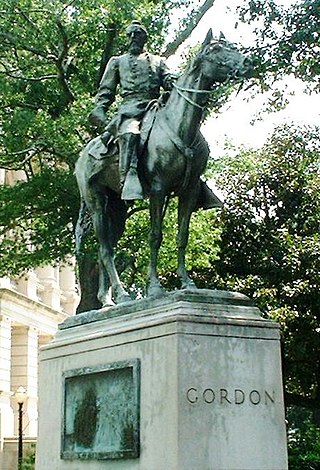
The equestrian statue of John Brown Gordon is a monument on the grounds of the Georgia State Capitol in Atlanta, Georgia, United States. The monument, an equestrian statue, honors John Brown Gordon, a general in the Confederate States Army during the American Civil War who later become a politician in post-Reconstruction era Georgia. Designed by Solon Borglum, the statue was dedicated in 1907 to large fanfare. The statue has recently become a figure of controversy over Gordon's racist views and associations with the Confederacy, with some calling for its removal.

The Martin Luther King Jr. statue is a public monument of civil rights activist Martin Luther King Jr. in Atlanta, Georgia. The statue, designed by Martin Dawe, was unveiled in 2017 and stands on the grounds of the Georgia State Capitol, overlooking Liberty Plaza.
The Ellis Arnall statue is a public monument located on the grounds of the Georgia State Capitol in Atlanta, Georgia. Honoring Georgia Governor Ellis Arnall, the statue was sculpted by Zenos Frudakis and unveiled in 1997.

The Thomas E. Watson statue is a public monument located near the Georgia State Capitol in Atlanta, Georgia. Dedicated in 1932, the statue honors Georgian politician Thomas E. Watson, who served terms in the United States Congress as both a Representative and Senator in the late 1800s and early 1900s. Originally located on the steps of the capitol building, the statue was removed from this location in 2013 and relocated to a nearby plaza.

The Jimmy Carter statue is a monumental statue in Atlanta, Georgia, United States. Located on the grounds of the Georgia State Capitol, the statue was designed by Frederick Hart and depicts Jimmy Carter, former president of the United States. It was dedicated in 1994.
